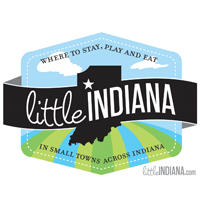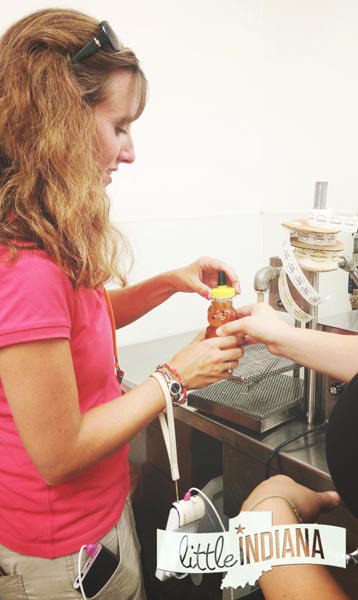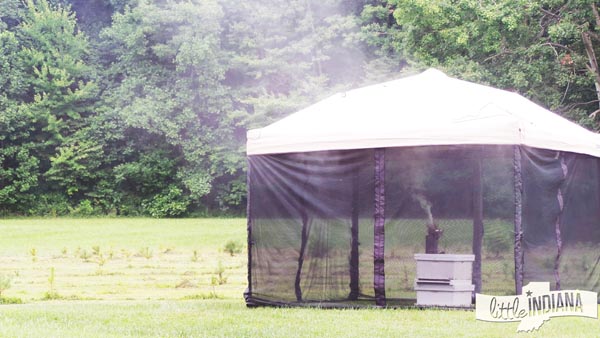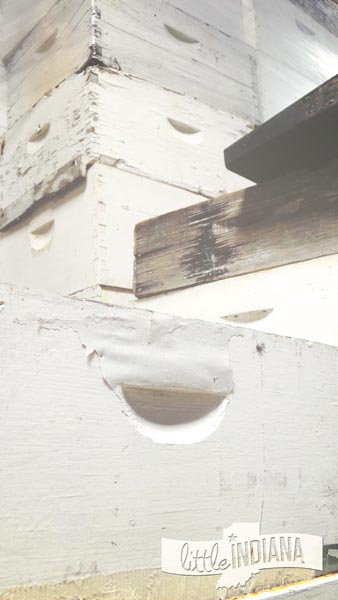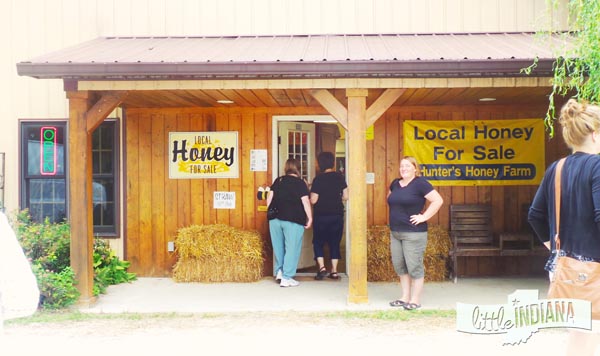
The Exterior of Hunter’s Honey Farm in Martinsville, Indiana: Tosha from Visit Morgan County Greets Our Small Group
At Hunter’s Honey Farm in Martinsville, Indiana, some might say that honey runs through their veins. That’s because four generations of the Hunter family have worked with bees.
It all begin with Gilbert Perigo. He’s the family patriarch who began dabbling with beekeeping, snagging his first swarm when he was in high school. By 1910, he had several hives that he used to pollinate the family orchard. It took time to grow the hives because this was not his full-time job. Gilbert was a teacher. But over the years, he kept adding to his aviary, or bee yard (a place where honeybees are kept), reaching 800 hives!
Fourth Generation Honey Farm
After he retired from teaching in 1951, he became the Chief Apiary Inspector for the Indiana Department of Natural Resources. Of his five daughters, one of them, Marian, began her own bee yard with somewhere around a dozen hives. She and her husband, Max Hunter, had three children. The youngest of the three, Tracy, learned the art of beekeeping from his grandpa, Gilbert Perigo.
Following in his grandfather’s footsteps, Tracy (with the help of his grandpa) hived his first swarm in downtown Mooresville, Indiana. After he graduated from Purdue University, he married Christina Ramsay, and they added to the apiary, hitting 500 hives in 1998. Tracy and Christina are teachers during the school year. In the spring of 2004, they carried on the tradition when their ten year old son, Ross, hived his first swarm in Mooresville with his father’s help.
Hunter’s Honey Farm combines education with agriculture, offering tours to groups large and small, in addition to their retail space and Christmas tree farm. It’s an agrotourism destination. For those who may be unfamiliar with that term, it’s a fancy way of saying that this is a working farm that offers a chance for visitors to take a tour. It’s a great way to get a look at the kind of work that accompanies whatever sort of tour the establishment is offering. Join me! During my visit to the honeybee farm, I had a chance to learn first-hand about these busy little bees from Emma, who shared the bottling process with our group, and Lanny, who took us through the parts of the hive, while on the search for the elusive queen bee.
Tours at Hunter’s Honey Farm
If you watch the tour above, you can get an idea of the kind of work involved behind the scenes. It’s very interesting! Although I know a few people with hives, this was my first tour with a larger commercial operation that sells wholesale and resale honey.
During our visit, we had the chance to hand-roll beeswax candles and to fill up our own little bear of honey! This is the good stuff. All too often, the honey you find at the grocery store is devoid of its pollen! In a revealing 2011 study by Food Safety News, in association with Vaughn Bryant, a professor and expert in dealing with pollen in honey, from Texas’ A&M University, after sorting through 60 bottles of honey, he discovered that 76% of samples bought at grocery stores had all the pollen removed! All of the pharmacy honey lacked pollen and 77% of big box retail stores lacked pollen as well. What does this mean for you? Well, it’s just one more reason to support your local area bee farmer and farmer’s market! Yes, this local honey is filtered in a traditional method that will remove the bee parts and pieces of honeycomb, but leaves behind the pollen.
This filtered honey can come from anywhere–including places that have been banned in other countries because of contamination by antibiotics and heavy metal, according to the test provider. It may have been filtered in a different country to have its pollen removed, thus removing its only built-in tracking device. It’s an eye-opening look at the international honey business, and I highly suggest a read through the article (I linked it above). But this filtered honey is in demand from the grocery stores who want a product that can sit on their shelves…indefinitely. Although the study is four years old, judging from the lack of crystallization found in these stores today, I’m going to say that I doubt any changes have been made.
But did you know that real honey SHOULD become crystallized? In fact, it is still something that can be stored indefinitely, it just needs to sit in a bit of hot water to thin out–while still retaining its nutritional properties. It may not look pretty on the shelf once it crystallizes, but in terms of nutrition, go with the good, local stuff like at your local Indiana Farmer’s Market (ask around in your area for a beekeeper near you) or choose bottles labeled “organic” to keep additives like corn syrup out of there (if you must shop at the grocery stores for your honey). But back to the amazing tour and Hunter’s Honey Farm.
Busy as a Bee
Honeybees have it rough. Not only are they responsible for something like one out of every three bites of food we eat, but they are tasked with keeping their queen alive, when they aren’t getting swatted at by humans or locked inside of cars and trucks. It’s a hard life. But it’s even harder for the females!
The female workers, are so busy collecting pollen, that they typically only live five to six weeks. The reason for that is–they work themselves to death! Lanny shared more about the hive: “The females, the workers, live five-six weeks, because they work themselves to death. Those who emerge October and on can possibly live until springtime because all the work is basically done. The drones, they don’t work! They don’t even feed themselves!
The workers feed them and the guys just hang around and beg for food. The only purpose for the drones is to mate with the queen and only a few of them do that. But God did say if you don’t work, you don’t eat. Come just a few weeks down here (this was in August), they are going to be kicked out. And, yup, they’re done. So this is the point where I tell the young people coming through that that ‘Oh, yeah, that sounds pretty neat’ but there’s a downside. You better pull your weight or you’re gone.”
One worker bee in her lifetime will produce 1/12 teaspoon of #honey! Click To TweetOne bee, one worker bee, in her lifetime, will produce about 1/12 of a teaspoon of honey. Basically, one colony will produce one pound of wax and six pounds of honey, depending on the resources. This past six weeks we have been having all kinds of rain. When you get rain, it washes out the nectar, the pollen. They don’t have anything to eat. They have been eating all their resources, of what they had stored before, and therefore, we aren’t getting the honey that we have planned on, so things have been taking a step back. It’s starting to come back in now, and it depends on what part of the state (the hive is in), [if] they are getting more than others.
How Bees Communicate
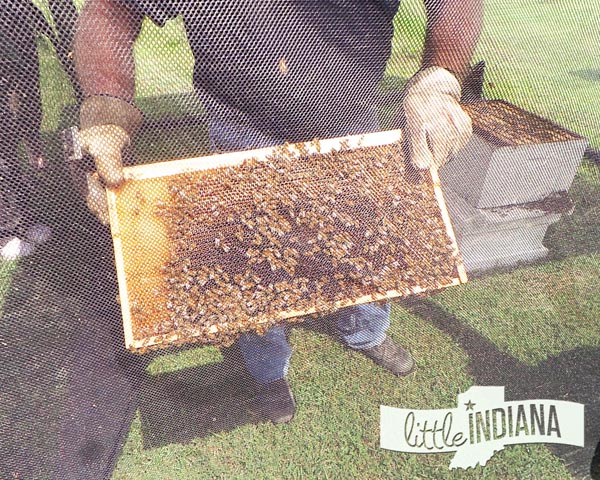
Inside the Screen, Lanny Shares the Different Parts of the Hive at Hunter’s Honey Farm in Martinsville, Indiana
“The main communication in the hive is by pheromones, by scent, and that’s why we use the smoker, to disrupt their communication, because one of the four jobs that the bees rotate through in their lifetime is guard bees. Their job is to protect the hive and warn the colony of problems–and if they perceive that I am a problem, then I might be hurting. So smoke in the front will disrupt their communication and, depending on their attitude, it depends on how much smoke I need to use.” Lanny shared that just like people, some hives are nicer than others. But, no, they don’t remember which hive is which.
Lanny talked about the division of the colony, “In one hive, one colony, you have one queen. She’s not like the Queen of England or like mom: she doesn’t tell anybody what to do. In fact, the girls, which are the workers, are the ones that control the hive and will tell her what to do and when to do it. But she has a pheromone, sort of like perfume, that mom wears at home, and everybody in the colony wears that scent and that identifies them as part of the family. Without that scent, other bees coming in would have a little bit of a problem.”
The Queen Bee is not like the Queen of England or like Mom... #honey Click To Tweet“This is a hive tool I am using, like a little pry bar. We start out with a foundation. It is naturally made with beeswax as you can see right here. The girls draw that out. When a worker bee emerges from the cell, each one of the holes here are reffered to as a cell, she is covered with hair. She has four wings, six legs, two stomachs, two glands, and a stinger. That is her equipment that she uses throughout her life. She might use them all at the same time but the gland that I refer to is in the abdomen. It produces wax.”
So, how come you don’t have one of those bee suits on? “If I can get away with it, I prefer not to. But if I’m going to be down, working all day, then yes, I wear it. In fact, sometimes like this morning, when I move this out, I just put my jacket on, because I wasn’t sure how prickly they were going to be.”
There are four kinds of bee jobs. Lanny said, “Housekeeping is first, then the nursery bees. Nursery bees take care of the young. Then there’s guard bees, then the field bees, they go out and collect whatever they need for the hive. When they get to the flower, they suck up the nectar, and put it in their second stomach. Remember, they have two stomachs. One is for their own body, the other one is for carrying.”
He continued, “So when they go to a flower, they will suck up the nectar and store it in the second stomach. While they are in the flower, they will collect pollen on the hairs of their body. When they are done with that crop they will move onto the next. Roughly 75% of what we eat is pollinated by the honey bees. If we didn’t have honeybees, we wouldn’t be doing too well.”
“So once their stomach is full, then they’ll go back to the hive, pass off the pollen to their sisters that are housekeepers,” he explained. “Housekeepers are the ones that put the food away. So they pass the pollen off and barf up that nectar/honey because they are adding different goodies from their own body, different enzymes and that is the process to making honey. They barf it up, give it to their sisters, the sisters put it in the cells, they dry it down to a 17% moisture content, and they they’ll put a wax cap on it.”
While pulling out the next section of hive, he walked around, showing us the top of it, saying, “If you took a basketball, squeezed it, and put it in this box, that would be the shape of the brood chamber. Brood is the first three stages of a bee’s life: there’s egg, larvae, cupid, and adult. Once they transfer from a teenager to an adult, they chew their way through a cap and then they emerge.”
“If you look on here, you can see the shape of the basketball. The darker comb is where the brood, the young, have been raised. Down inside there’s whitish material down here in the bottom of the cell called royal jelly. that is fed through the first and halfway through the second stage of eggs and larva. Notice they put the food around the brood chamber. When they get really crowded, they will start putting it in the brood chamber. You can have all stages on one (frame), like the first one was the beginning of honey, the second one was totally honey, and this (the third one) was a mix. Usually you put these around the brood chamber.”
How long does it take to hatch a bee? Lanny didn’t hesitate, “Twenty-one days for a worker, fifteen-sixteen for a queen, twenty-four for a drone.”
So, what do bees eat? “Pollen and honey/nectar is their main food. Royal jelly is created by the worker bees that are nursery bees.” Lanny shared that it is produced via the gland.
If the queen bee doesn’t get to boss everyone around, what exactly does she do? Lanny shared, “The queen will lay between 1 and 2 thousand eggs a day at the peak of the season. We just passed the peak in the past month (our tour was in August). Each have their own cups. When they want to raise a queen, they will draw it out about an inch long. There is only one queen for colony.” The queen will live for two to five years.
“They are getting prepared for her arrival. When they get crowded, it’s called swarming. The workers will build cells, queen cells, all over in the hive, usually on the bottom of the frame. Every cell has to be polished and clean before it is used.” It isn’t easy to see the queen bee. In fact, we went through most of the frames until she was spotted. But for those who aren’t able to take a tour, though I highly recommend it, you can at least see the observation hive inside.
Lanny had something a little darker to share about the role of the queen, “The observation hive inside now is queen-less. We added some bees to it last week because it was getting real thin, not enough bees in there, and the new ones ended up killing her. So we are going to have to rework it and get another queen in.” “Why would they kill her?” I asked. He responded, “Because it wasn’t their queen. There wren’t enough of the others (those from her previous colony) to protect her. Sometimes that happens and sometimes you can get away with it but this time we didn’t.” The poor queen! “How long will it take to get another queen?” I wanted to know. Lanny answered, “We are going to take another hive and take a couple frames from it with their queen to put in there.”
With the tent keeping the bees enclosed as he shows the parts of the hive, it isn’t very common for folks on the tour to get stung, although it has happened. If you don’t start swinging, you are more likely to be okay but, as Lanny says, sometimes that doesn’t matter. But what about what happens inside the tent if he burned through all the hay in his smoker? He would be leaving. As we watched, the bees flew out of the hive more and more. It started to make all of us watching a bit jumpy! Lanny shared that at one time he thought he hated bees–until he realized that he didn’t hate bees, he hates pain! I so get that.
The State of Honeybees
“So, how is the bee population doing? Is it starting to come back?” he was asked. Lanny shared a frightening fact, “We are still down about 1/3. In fact, at one point it raised above that, but I never did hear anything official saying definitely where it was at.” That’s alarming. But what’s more alarming is the role that pesticides likely play in the mass death of the honeybees. Neonicotinoids are thought to be a pretty big culprit. Nearly all of the corn grown here in the US is treated with this substance. These chemicals become a part of the plant so that when a bee ingests the nectar, it also takes in this chemical. One study has shown that it may make the bees confused and unable to return back to the hive. They call it homing failure. The New York Times notes that:
The U.N. Food and Agriculture Organization notes that 71 of the 100 crops that provide 90 percent of human food are pollinated by bees. Estimates of the value to those crops run to as much as $200 billion annually.
A different bee farmer I spoke with recently stated that he has to make sure that his hives aren’t near the farmer’s fields because, when they spray the fields, no good comes to his beehives. If pesticides are affecting bees so much, what are they doing to us? Fortunately, bees are able to help detoxify pesticides a little bit. But when you add in the viruses, flowerless landscapes, parasites, and other pests, and it is clear that honeybees have a lot to deal with! With so many mouths to feed, it is not an easy problem to fix. The government has released a large document detailing how they plan to tackle bee losses–and hope to turn it around to more acceptable numbers.
It’s interesting to note that while the honeybee deaths are alarming, I’ve spoken to some folks who view it as a blessing in disguise, that maybe we should be looking more at the big picture. Maybe we should be figuring out how to take better care of our environment to prevent creating such an impact on such a necessary little bug. Plant flowers, resist the urge to fertilize our own lawns, and work to create safe places for bees to do what bees do.
The Buzz at Hunter’s Honey Farm
It was an absolutely wonderful tour. Emma and Lanny do such a great job! I think this would be particularly interesting for schoolkids. I mean, I found it pretty interesting, and I have a whole love/hate relationship with bees. You see, when I was a kid, I was visiting at my grandma’s house, playing with the girl across the street. Lisa was slightly older than I and, when we noticed a stream of bees flying out from a hole in the brick home at the foundation, we regarded it with fascination and a little excitement. At first.
She then turned to me and told me that they wouldn’t sting me. Unless I were wearing yellow. I looked down at my shirt–my Rainbow Brite shirt covered in glittering yellow stars–and freaked out! I think that kind of stayed with me. Bees make me move like I’m an Olympic gymnast competing for the gold.
Fortunately, my frequent exposure to bee hives at Indiana pumpkin patches and apple orchards around the state combined with a bit of knowledge, has helped me not feel as though I am going to swarmed and stung to death. It only took a few decades. For the Hunter family of Hunter’s Honey Farm in Martinsville, Indiana, honey has been a part of their lives for so long, it probably feels like second nature. Get a taste of the excitement with their well-stocked retail shop. Products are also available online (linked below).
You can follow along in their adventures by heading over to the Hunter’s Honey Farm Facebook Page, the Twitter page, or their website, linked below.
Since this is a working farm, please call ahead before making a special trip. But you knew that already, didn’t you?
Special thanks for Visit Morgan County for arranging this informative visit. Thanks Tosha!
Small Towns: Destinations, not Drive-Thrus! I’m Jessica Nunemaker and THIS is Little Indiana.
Just don’t forget to tell ’em that Little Indiana sent you.
Hunter’s Honey Farm
6501 W Honey Lane
Martinsville, IN 46151
765.537.9430
Targeted. Relevant. Affordable! Little Indiana advertising.
